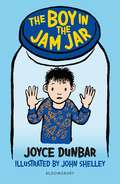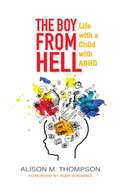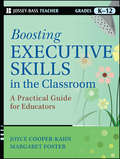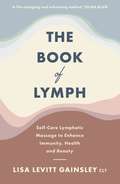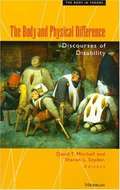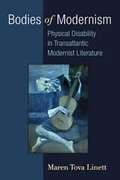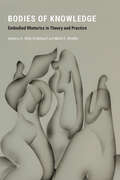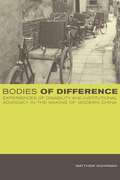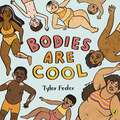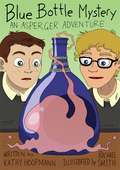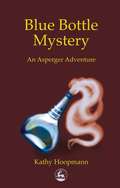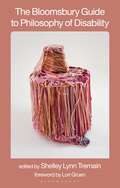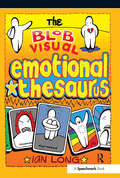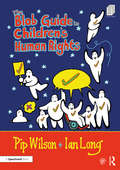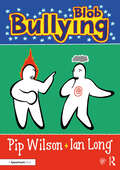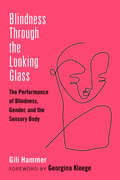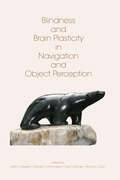- Table View
- List View
The Boy in the Jam Jar: A Bloomsbury Reader (Bloomsbury Readers)
by Joyce Dunbar'Joyce Dunbar is one of the best writers for children today.' (The Guardian)A powerful and personal story from Joyce Dunbar about what it's like to experience hearing difficulties.Dylan can't hear as well as he used to be able to and he doesn't want to be different from his friends - he wants to be able to hear like everyone else. As his hearing gets worse he becomes more and more isolated from his friends. Luckily his dog Pluto is there to keep him down to earth... This heartwarming story from Joyce Dunbar has beautiful black-and-white illustrations by TBC and is perfect for children who are developing as readers.The Bloomsbury Readers series is packed with brilliant books to get children reading independently in Key Stage 2, with book-banded stories by award-winning authors like double Carnegie Medal winner Geraldine McCaughrean and Waterstones Prize winner Patrice Lawrence, covering a wide range of genres and topics. With charming illustrations and online guided reading notes written by the Centre for Literacy in Primary Education (CLPE), this series is ideal for reading both in the classroom and at home. For more information visit www.bloomsburyguidedreading.com.Book Band: LimeIdeal for ages 6+
The Boy from Hell: Life with a Child with ADHD
by Alison M. Thompson Rory BremnerFor Alison, life with her son Daniel sometimes seemed like an endless round of difficulties: disobedience, backchat, rudeness, name-calling and aggression. Upon starting school, where his aggression and lack of concentration concerned teachers, Daniel was given a vague diagnosis of borderline Attention Deficit Hyperactivity Disorder (ADHD), which was later changed to ADHD with secondary Oppositional Defiant Disorder and autistic traits. In this honest account of the first 18 years of Daniel's life, Alison exposes her own worries, doubts, and exceptional courage at every pivotal turn in Daniel's life. Interspersing the narrative with tips and advice on what she has found useful - or not - in bringing up Daniel, Alison also provides encouraging guidance for teachers and fellow parents. This book also raises serious questions about how the education system supports children with special needs, and if medication can be the answer to managing ADHD in children.
The Boy from Hell: Life with a Child with ADHD
by Alison M. Thompson Rory BremnerFor Alison, life with her son Daniel sometimes seemed like an endless round of difficulties: disobedience, backchat, rudeness, name-calling and aggression. Upon starting school, where his aggression and lack of concentration concerned teachers, Daniel was given a vague diagnosis of borderline Attention Deficit Hyperactivity Disorder (ADHD), which was later changed to ADHD with secondary Oppositional Defiant Disorder and autistic traits. In this honest account of the first 18 years of Daniel's life, Alison exposes her own worries, doubts, and exceptional courage at every pivotal turn in Daniel's life. Interspersing the narrative with tips and advice on what she has found useful - or not - in bringing up Daniel, Alison also provides encouraging guidance for teachers and fellow parents. This book also raises serious questions about how the education system supports children with special needs, and if medication can be the answer to managing ADHD in children.
Bothered: Helping Teenagers Talk About Their Feelings
by Margot SunderlandAt this challenging developmental stage, when teenagers are finding things difficult, this book can really help. It is full of tools and techniques of what to say and how to be, enabling teenagers to move from unhappiness, poor functioning or learning blocks, to a place of self-awareness, self esteem and the ability to thrive. The first part of the book offers a key assessment tool, namely 'The Teenager Well-Being Profile'. This is designed for people to easily assess just how well the teenager is doing in their life emotionally and relationally. If the teenager is messing up in some areas, the Well-Being Profile will show clearly which life skill he or she has not yet mastered. The accompanying, empowering worksheets address key feelings, issues and concerns common to teenagers. The worksheets enable adults to be with the teenager in a confident, non-embarrassing and effective way so that the conversation flows. This book provides a real opportunity for transformational conversations that will really make a difference.
Boosting Executive Skills in the Classroom: A Practical Guide for Educators
by Joyce Cooper-Kahn Margaret FosterA guide for helping students with weak Executive Function skills to learn efficiently and effectively Students with weak Executive Function skills need strong support and specific strategies to help them learn in an efficient manner, demonstrate what they know, and manage the daily demands of school. This book shows teachers how to do exactly that, while also managing the ebb and flow of their broader classroom needs. From the author of the bestselling parenting book Late, Lost, and Unprepared, comes a compilation of the most practical tools and strategies, designed to be equally useful for children with EF problems as well as all other students in the general education classroom. Rooted in solid research and classroom-tested experience, the book is organized to help teachers negotiate the very fluid challenges they face every day; educators will find strategies that improve their classroom "flow" and reduce the stress of struggling to teach students with EF weaknesses. Includes proven strategies for teachers who must address the needs of students with Executive Function deficits Contains information from noted experts Joyce Cooper-Kahn, a child psychologist and Margaret Foster, an educator and learning specialist Offers ways to extend learning and support strategies beyond the classroom The book's reproducible forms and handouts are available for free download This important book offers teachers specific strategies to help students with EF deficits learn in an efficient manner, demonstrate what they know, and manage the daily demands of school.
Boosting Executive Skills in the Classroom: A Practical Guide for Educators
by Joyce Cooper-Kahn Margaret FosterA guide for helping students with weak Executive Function skills to learn efficiently and effectively Students with weak Executive Function skills need strong support and specific strategies to help them learn in an efficient manner, demonstrate what they know, and manage the daily demands of school. This book shows teachers how to do exactly that, while also managing the ebb and flow of their broader classroom needs. From the author of the bestselling parenting book Late, Lost, and Unprepared, comes a compilation of the most practical tools and strategies, designed to be equally useful for children with EF problems as well as all other students in the general education classroom. Rooted in solid research and classroom-tested experience, the book is organized to help teachers negotiate the very fluid challenges they face every day; educators will find strategies that improve their classroom "flow" and reduce the stress of struggling to teach students with EF weaknesses. Includes proven strategies for teachers who must address the needs of students with Executive Function deficits Contains information from noted experts Joyce Cooper-Kahn, a child psychologist and Margaret Foster, an educator and learning specialist Offers ways to extend learning and support strategies beyond the classroom The book's reproducible forms and handouts are available for free download This important book offers teachers specific strategies to help students with EF deficits learn in an efficient manner, demonstrate what they know, and manage the daily demands of school.
The Book of Lymph: Self-care Lymphatic Massage to Enhance Immunity, Health and Beauty
by Lisa Levitt GainsleyThe Book of Lymph will give you quick, easy and therapeutic lymph-optimisation strategies, using the simple healing magic of your own touch.The lymphatic system is the body's first line of defence against illness and is responsible for ridding the body of toxins, waste and other unwanted materials. When it's not functioning well, it's easy to see and feel the bloat, puffiness and general malaise it causes. Lisa Levitt Gainsley combines her 25 years of experience as a lymph specialist with scientific know-how to show us how lymphatic treatment is the missing link to our most common health woes. She shows us how lymphatic drainage can provide us with pain relief, inflammation reduction, weight loss, brighter skin and generally better health. From three-to-five-minute massage sequences to backed-up research into the effectiveness of lymphatic drainage, The Book of Lymph will put you on the path to taking control of how you feel, reducing bloating and puffiness independently. The first book of its kind, The Book of Lymph will help you to live a pain-free life.'Well-functioning lymphatic drainage is the key to great, clear, glowing skin.' - Vogue 'I am so grateful Lisa is sharing her wisdom and techniques with us. Truly a life-changing and enhancing method.' - Selma Blair, Actress'Lisa's lymphatic self-massage techniques have changed my life and my body dramatically - specifically by reducing chronic pain symptoms and helping to balance out my hormones.' - Jessica Zanotti'I am beyond thrilled for the world to get a dose of Lisa's kind and gentle, but powerful and life-changing knowledge and be equipped to try some of it out on their own bodies.' - Freida Pinto, Actress
The Body And Physical Difference: Discourses Of Disability
by David T. Mitchell Sharon L. SnyderFor years the subject of human disability has engaged those in the biological, social and cognitive sciences, while at the same time, it has been curiously neglected within the humanities. The Body and Physical Difference seeks to introduce the field of disability studies into the humanities by exploring the fantasies and fictions that have crystallized around conceptions of physical and cognitive difference. Based on the premise that the significance of disabilities in culture and the arts has been culturally vexed as well as historically erased, the collection probes our society's pathological investment in human variability and "aberrancy. " The contributors demonstrate how definitions of disability underpin fundamental concepts such as normalcy, health, bodily integrity, individuality, citizenship, and morality--all terms that define the very essence of what it means to be human. The book provides a provocative range of topics and perspectives: the absence of physical "otherness" in Ancient Greece, the depiction of the female invalid in Victorian literature, the production of tragic innocence in British and American telethons, the reconstruction of Civil War amputees, and disability as the aesthetic basis for definitions of expendable life within the modern eugenics movement. With this new, secure anchoring in the humanities, disability studies now emerges as a significant strain in contemporary theories of identity and social marginality. Moving beyond the oversimplication that disabled people are marginalized and made invisible by able-ist assumptions and practices, the contributors demonstrate that representation is founded upon the perpetual exhibition of human anomalies. In this sense, all art can be said to migrate toward the "freakish" and the "grotesque. " Such a project paradoxically makes disability the exception and the rule of the desire to represent that which has been traditionally out-of-bounds in polite discourse. The Body and Physical Difference has relevance across a wide range of academic specialties such as cultural studies, the sociology of medicine, history, literature and medicine, the allied health professions, rehabilitation, aesthetics, philosophical discourses of the body, literary and film studies, and narrative theory. David T. Mitchell is Assistant Professor of English, Northern Michigan University. Sharon L. Snyder teaches film and literature at Northern Michigan University.
Bodies of Modernism: Physical Disability in Transatlantic Modernist Literature
by Maren LinettBodies of Modernism brings a new and exciting analytical lens to modernist literature, that of critical disability studies. The book offers new readings of canonical and noncanonical writers from both sides of the Atlantic including Flannery O’Connor, Eudora Welty, H. G. Wells, D. H. Lawrence, Elizabeth Bowen, Henry Green, Olive Moore, Carson McCullers, Tennessee Williams, J. M. Synge, Florence Barclay, Virginia Woolf, and James Joyce. Through readings of this wide range of texts and with chapters focusing on mobility impairments, deafness, blindness, and deformity, the study reveals both modernism’s skepticism about and dependence on fantasies of whole, “normal” bodies.
Bodies of Knowledge: Embodied Rhetorics in Theory and Practice
by A. Abby Knoblauch Marie E. MoellerBodies of Knowledge challenges homogenizing (mis)understandings of knowledge construction and provides a complex discussion of what happens when we do not attend to embodied rhetorical theories and practices. Because language is always a reflection of culture, to attempt to erase language and knowledge practices that reflect minoritized and historically excluded cultural experiences obscures the legitimacy of such experiences both within and outside the academy. The pieces in Bodies of Knowledge draw explicit attention to the impact of the body on text, the impact of the body in text, the impact of the body as text, and the impact of the body upon textual production. The contributors investigate embodied rhetorics through the lenses of race and ethnicity, gender and sexuality, disability and pain, technologies and ecologies, clothing and performance, and scent, silence, and touch. In doing so, they challenge the (false) notion that academic knowledge—that is, “real” knowledge—is disembodied and therefore presumed white, middle class, cis-het, able-bodied, and male. This collection lays bare how myriad bodies invent, construct, deliver, and experience the processes of knowledge building. Experts in the field of writing studies provide the necessary theoretical frameworks to better understand productive (and unproductive) uses of embodied rhetorics within the academy and in the larger social realm. To help meet the theoretical and pedagogical needs of the discipline, Bodies of Knowledge addresses embodied rhetorics and embodied writing more broadly though a rich, varied, and intersectional approach. These authors address larger questions around embodiment while considering the various impacts of the body on theories and practices of rhetoric and composition. Contributors: Scot Barnett, Margaret Booker, Katherine Bridgman, Sara DiCaglio, Kristie S. Fleckenstein, Vyshali Manivannan, Temptaous Mckoy, Julie Myatt, Julie Nelson, Ruth Osorio, Kate Pantelides, Caleb Pendygraft, Nadya Pittendrigh, Kellie Sharp-Hoskins, Anthony Stagliano, Megan Strom
Bodies of Difference: Experiences of Disability and Institutional Advocacy in the Making of Modern China (PDF)
by Matthew KohrmanBodies of Difference chronicles the compelling story of disability's emergence as an area of significant sociopolitical activity in contemporary China. Keenly attentive to how bodies are embedded in discourse, history, and personal exigency, Matthew Kohrman details ways that disability became a fount for the production of institutions and identities across the Chinese landscape during the final decades of the twentieth century. He looks closely at the creation of the China Disabled Persons' Federation and the lives of numerous individuals, among them Deng Pufang, son of China's Communist leader Deng Xiaoping.
Bodies Are Cool: A picture book celebration of all kinds of bodies
by Tyler FederThis body positive picture book is a vibrant, joyful, and judgement-free celebration of every body shape and size.My body, your body, every different kind of body!All of them are good bodies! BODIES ARE COOL!This heart-warming, inclusive book, filled with detailed and friendly illustration is a celebration of every kind of body that exists in the world. Through an empowering, rhythmic text that is perfect for reading aloud, little ones can explore various skin tones, body shapes, hair types, and more, in an accessible way that instills body positivity and confidence.The picture book debut from talented author/illustrator Tyler Feder, whose inclusive artwork - full of warmth and humour - has earned her a large social media following through her brand, Roaring Softly.
Blue Bottle Mystery - The Graphic Novel: An Asperger Adventure (PDF)
by Kathy HoopmannThis graphic novel re-telling of Kathy Hoopmann's best-selling Blue Bottle Mystery brings the much-loved fantasy story to life for a new generation of readers. The hero is Ben, a boy with Asperger Syndrome (AS). When Ben and his friend Andy find an old bottle in the school yard, little do they know of the surprises about to be unleashed in their lives. Bound up with this exciting mystery is the story of how Ben is diagnosed with AS and how he and his family deal with the problems and joys that come along with it.
Blue Bottle Mystery: An Asperger Adventure
by Kathy Hoopmann`I read this book in under an hour and then immediately picked it up and read it again, much to my brother's disappointment ('It's my book!') It is a story that succeeds in the challenge parents and siblings have been faced with for years - how to explain what Autism is without drowning people amidst technical terms and psychology. It contains a lot of information whilst still being an intriguing tale of a boy's adventure that would excite any child whether they had autism or not. It was a wonderful to listen to my brothers cries of 'Oh now I understand,' ' I do that,' ' Aspergers - that's what I have.' The story highlights the problems for family and friends of Autistic children and for the children themselves and allows the reader to take up their part in the story. It provides advice and support, a good explanation of Autism and a heart-warming story. We shall have to buy another copy because both my brother and I love it too much to let the other have a read. My only criticism is that it does not make a good bed-time story as my brother would not go to sleep; he wanted to hear more of the story and tell me more about what he had read. Congratulations on a truly wonderful book. Best of luck.' - Clare Truman (age 14) This is a warm, fun-filled fantasy story for children with a difference: the hero is Ben, a boy with Asperger Syndrome. When Ben and his friend Andy find an old bottle in the school yard, they little realize the surprises about to be unleashed in their lives. Bound up with this exciting mystery is the story of how Ben is diagnosed with Asperger Syndrome and how he and his family deal with the problems and joys that come along. Blue Bottle Mystery is a delight to read that is more than just another kid's book. For the first time, the issues and frustrations that a child may have with Asperger Syndrome are explored within a fictional format especially for children. Its portrayal of Ben as the central character offers other children with autistic spectrum disorders and their peers a positive role model. It is a valuable teaching tool that demystifies children with Asperger Syndrome, justifying their individuality as valid and interesting. In Blue Bottle Mystery Kathy Hoopmann has combined her love of children with her passion for fantasy literature to produce a delightful read for anyone who loves an adventure and wants a unique insight into the mind of an Asperger child.
Blue Bottle Mystery: An Asperger Adventure (PDF)
by Kathy Hoopmann`I read this book in under an hour and then immediately picked it up and read it again, much to my brother's disappointment ('It's my book!') It is a story that succeeds in the challenge parents and siblings have been faced with for years - how to explain what Autism is without drowning people amidst technical terms and psychology. It contains a lot of information whilst still being an intriguing tale of a boy's adventure that would excite any child whether they had autism or not. It was a wonderful to listen to my brothers cries of 'Oh now I understand,' ' I do that,' ' Aspergers - that's what I have.' The story highlights the problems for family and friends of Autistic children and for the children themselves and allows the reader to take up their part in the story. It provides advice and support, a good explanation of Autism and a heart-warming story. We shall have to buy another copy because both my brother and I love it too much to let the other have a read. My only criticism is that it does not make a good bed-time story as my brother would not go to sleep; he wanted to hear more of the story and tell me more about what he had read. Congratulations on a truly wonderful book. Best of luck.' - Clare Truman (age 14) This is a warm, fun-filled fantasy story for children with a difference: the hero is Ben, a boy with Asperger Syndrome. When Ben and his friend Andy find an old bottle in the school yard, they little realize the surprises about to be unleashed in their lives. Bound up with this exciting mystery is the story of how Ben is diagnosed with Asperger Syndrome and how he and his family deal with the problems and joys that come along. Blue Bottle Mystery is a delight to read that is more than just another kid's book. For the first time, the issues and frustrations that a child may have with Asperger Syndrome are explored within a fictional format especially for children. Its portrayal of Ben as the central character offers other children with autistic spectrum disorders and their peers a positive role model. It is a valuable teaching tool that demystifies children with Asperger Syndrome, justifying their individuality as valid and interesting. In Blue Bottle Mystery Kathy Hoopmann has combined her love of children with her passion for fantasy literature to produce a delightful read for anyone who loves an adventure and wants a unique insight into the mind of an Asperger child.
The Bloomsbury Guide to Philosophy of Disability
by Shelley Lynn TremainThe Bloomsbury Guide to Philosophy of Disability is a revolutionary collection encompassing the most innovative and insurgent work in philosophy of disability. Edited and anthologized by disabled philosopher Shelley Lynn Tremain, this book challenges how disability has historically been represented and understood in philosophy: it critically undermines the detrimental assumptions that various subfields of philosophy produce; resists the institutionalized ableism of academia to which these assumptions contribute; and boldly articulates new anti-ableist, anti-sexist, anti-racist, queer, anti-capitalist, anti-carceral, and decolonial insights and perspectives that counter these assumptions. This rebellious and groundbreaking book's chapters–most of which have been written by disabled philosophers–are wide-ranging in scope and invite a broad readership. The chapters underscore the eugenic impetus at the heart of bioethics; talk back to the whiteness of work on philosophy and disability with which philosophy of disability is often conflated; and elaborate phenomenological, poststructuralist, and materialist approaches to a variety of phenomena. Topics addressed in the book include: ableism and speciesism; disability, race, and algorithms; race, disability, and reproductive technologies; disability and music; disabled and trans identities and emotions; the apparatus of addiction; and disability, race, and risk. With cutting-edge analyses and engaging prose, the authors of this guide contest the assumptions of Western disability studies through the lens of African philosophy of disability and the developing framework of crip Filipino philosophy; articulate the political and conceptual limits of common constructions of inclusion and accessibility; and foreground the practices of epistemic injustice that neurominoritized people routinely confront in philosophy and society more broadly.A crucial guide to oppositional thinking from an international, intersectional, and inclusive collection of philosophers, this book will advance the emerging field of philosophy of disability and serve as an antidote to the historical exclusion of disabled philosophers from the discipline and profession of philosophy.The Bloomsbury Guide to Philosophy of Disability is essential reading for faculty and students in philosophy, disability studies, political theory, Africana studies, Latinx studies, women's and gender studies, LGBTQ studies, and cultural studies, as well as activists, cultural workers, policymakers, and everyone else concerned with matters of social justice.Description of the book's cover: The book's title appears on two lines across the top of the cover which is a salmon tone. The names of the editor and the author of the foreword appear in white letters at the bottom of the book. The publisher's name is printed along the right side in white letters. At the centre, a vertical white rectangle is the background for a sculpture by fibre artist Judith Scott. The sculpture combines layers of shiny yarn in various colours including orange, pink, brown, and rust woven vertically on a large cylinder and horizontally around a smaller cylinder, as well as blue yarn woven around a protruding piece at the bottom of the sculpture. The sculpture seems to represent a body and head of a being sitting down, a being with one appendage, a fat person, or a little person.
The Bloomsbury Guide to Philosophy of Disability
The Bloomsbury Guide to Philosophy of Disability is a revolutionary collection encompassing the most innovative and insurgent work in philosophy of disability. Edited and anthologized by disabled philosopher Shelley Lynn Tremain, this book challenges how disability has historically been represented and understood in philosophy: it critically undermines the detrimental assumptions that various subfields of philosophy produce; resists the institutionalized ableism of academia to which these assumptions contribute; and boldly articulates new anti-ableist, anti-sexist, anti-racist, queer, anti-capitalist, anti-carceral, and decolonial insights and perspectives that counter these assumptions. This rebellious and groundbreaking book's chapters–most of which have been written by disabled philosophers–are wide-ranging in scope and invite a broad readership. The chapters underscore the eugenic impetus at the heart of bioethics; talk back to the whiteness of work on philosophy and disability with which philosophy of disability is often conflated; and elaborate phenomenological, poststructuralist, and materialist approaches to a variety of phenomena. Topics addressed in the book include: ableism and speciesism; disability, race, and algorithms; race, disability, and reproductive technologies; disability and music; disabled and trans identities and emotions; the apparatus of addiction; and disability, race, and risk. With cutting-edge analyses and engaging prose, the authors of this guide contest the assumptions of Western disability studies through the lens of African philosophy of disability and the developing framework of crip Filipino philosophy; articulate the political and conceptual limits of common constructions of inclusion and accessibility; and foreground the practices of epistemic injustice that neurominoritized people routinely confront in philosophy and society more broadly.A crucial guide to oppositional thinking from an international, intersectional, and inclusive collection of philosophers, this book will advance the emerging field of philosophy of disability and serve as an antidote to the historical exclusion of disabled philosophers from the discipline and profession of philosophy.The Bloomsbury Guide to Philosophy of Disability is essential reading for faculty and students in philosophy, disability studies, political theory, Africana studies, Latinx studies, women's and gender studies, LGBTQ studies, and cultural studies, as well as activists, cultural workers, policymakers, and everyone else concerned with matters of social justice.Description of the book's cover: The book's title appears on two lines across the top of the cover which is a salmon tone. The names of the editor and the author of the foreword appear in white letters at the bottom of the book. The publisher's name is printed along the right side in white letters. At the centre, a vertical white rectangle is the background for a sculpture by fibre artist Judith Scott. The sculpture combines layers of shiny yarn in various colours including orange, pink, brown, and rust woven vertically on a large cylinder and horizontally around a smaller cylinder, as well as blue yarn woven around a protruding piece at the bottom of the sculpture. The sculpture seems to represent a body and head of a being sitting down, a being with one appendage, a fat person, or a little person.
The Blob Visual Emotional Thesaurus
by Ian LongThis unique visual thesaurus is designed to help writers of all ages to develop their emotional literacy. The book focuses solely upon emotions. Spanning circa 140 emotional words it is divided into three sections: ranges of emotions (offering a visual spectrum to be referred to by writers unsure of the intensity of feelings), synonyms (each image has similar images and words underneath it along with a sentence to help a new writer see how it can be embedded into a story), and antonyms - opposite pairs of feelings that are useful when wishing to create contrast in a storyline. This book will be a vital reference for every classroom and can be used individually or in whole class activities. Ian Long has worked as an artist with children, youth and adults. He has been a youth and children's worker in Gloucestershire, an artist-in-residence in Lambeth and is currently a teacher in a school in Marlborough. He is married to Jane and enjoys life with their two girls. Ian has illustrated many books for Pip.
The Blob Guide to Children’s Human Rights
by Pip Wilson Ian LongThis practical resource is designed to support children and young people as they develop an understanding of the basic rights that we are all entitled to as humans. Diverse and inclusive, Blob figures have proven themselves to be a valuable way of sparking discussion of difficult topics through the universal means of body language and feelings. Based upon the UN Convention on the Rights of the Child, this book introduces 'Blob Trees', lines and images with prompt questions and activities to help children to consider concepts such as freedom of movement and speech, safety and equality. It encourages children to think about the ways in which they can apply human rights articles to their own lives, by treating others with kindness, fairness and respect. Key features include: ‘How to use’ guides and prompt questions for each topic Simplified and child-friendly versions of all 42 human rights articles Photocopiable and downloadable worksheets designed to be used with individuals and groups of all sizes. With clear and supportive guidance and a graduated approach, this is an essential tool for teachers and practitioners looking to support an understanding of human rights in children and young people. It will also be invaluable for any groups wishing to develop accreditation for UNICEF’s ‘Rights Respecting Schools’ Awards.
The Blob Guide to Children’s Human Rights
by Pip Wilson Ian LongThis practical resource is designed to support children and young people as they develop an understanding of the basic rights that we are all entitled to as humans. Diverse and inclusive, Blob figures have proven themselves to be a valuable way of sparking discussion of difficult topics through the universal means of body language and feelings. Based upon the UN Convention on the Rights of the Child, this book introduces 'Blob Trees', lines and images with prompt questions and activities to help children to consider concepts such as freedom of movement and speech, safety and equality. It encourages children to think about the ways in which they can apply human rights articles to their own lives, by treating others with kindness, fairness and respect. Key features include: ‘How to use’ guides and prompt questions for each topic Simplified and child-friendly versions of all 42 human rights articles Photocopiable and downloadable worksheets designed to be used with individuals and groups of all sizes. With clear and supportive guidance and a graduated approach, this is an essential tool for teachers and practitioners looking to support an understanding of human rights in children and young people. It will also be invaluable for any groups wishing to develop accreditation for UNICEF’s ‘Rights Respecting Schools’ Awards.
Blob Bullying (Blobs)
by Pip Wilson Ian LongThis practical and accessible resource contains a wealth of discussion sheets and games to help victims of bullying reflect and talk about their experiences and feelings using the internationally familiar Blob figures. Diverse and inclusive, the Blob figures are a proven way to help children and adults share their feelings and experiences. Without age, culture or gender, they enable the individual to focus on feelings and body language. In this book, the Blobs explore bullying. From Blob Trees to Bingo games, cards and emotional scales, the Blobs provide a visual structure that allows children, teenagers and adults to open up about being bullied. Offering unique activities that help scaffold conversations for people of all ages and abilities, this is an essential resource for teachers, teaching assistants, youth and social workers, psychologists, counsellors and all those who work with and have caring responsibilities for others.
Blob Bullying (Blobs)
by Pip Wilson Ian LongThis practical and accessible resource contains a wealth of discussion sheets and games to help victims of bullying reflect and talk about their experiences and feelings using the internationally familiar Blob figures. Diverse and inclusive, the Blob figures are a proven way to help children and adults share their feelings and experiences. Without age, culture or gender, they enable the individual to focus on feelings and body language. In this book, the Blobs explore bullying. From Blob Trees to Bingo games, cards and emotional scales, the Blobs provide a visual structure that allows children, teenagers and adults to open up about being bullied. Offering unique activities that help scaffold conversations for people of all ages and abilities, this is an essential resource for teachers, teaching assistants, youth and social workers, psychologists, counsellors and all those who work with and have caring responsibilities for others.
Blindness Through the Looking Glass: The Performance of Blindness, Gender, and the Sensory Body (Corporealities: Discourses Of Disability)
by Gili HammerModern Western culture is saturated with images, imprinting visual standards of concepts such as beauty and femininity onto our collective consciousness. Blindness Through the Looking Glass examines how gender and femininity are performed and experienced in everyday life by women who do not rely on sight as their dominant mode of perception, identifying the multiple senses involved in the formation of gender identity within social interactions. Challenging visuality as the dominant mode to understand gender, social performance, and visual culture, the book offers an ethnographic investigation of blindness (and sight) as a human condition, putting both blindness and vision “on display” by discussing people’s auditory, tactile, and olfactory experiences as well as vision and sight, and by exploring ways that individuals perform blindness and “sightedness” in their everyday lives. Based on in-depth interviews with 40 blind women in Israel and anthropological fieldwork, the book investigates the social construction and daily experience of blindness in a range of domains. Uniquely, the book brings together blind symbolism with the everyday experiences of blind and sighted individuals, joining in mutual conversation the fields of disability studies, visual culture, anthropology of the senses, and gender studies.
Blindness and Brain Plasticity in Navigation and Object Perception
by John J. Rieser Daniel H. Ashmead Ford F. Ebner Anne L. CornResearch into the development of sensory structures in the brains of blind or visually-impaired individuals has opened a window into important ways in which the mind works. In these individuals, the part of the brain that is usually devoted to processing visual information is given over to increased processing of the touch and hearing sense. This d
Blindness and Brain Plasticity in Navigation and Object Perception
by John J. Rieser Daniel H. Ashmead Ford Ebner Anne L. CornResearch into the development of sensory structures in the brains of blind or visually-impaired individuals has opened a window into important ways in which the mind works. In these individuals, the part of the brain that is usually devoted to processing visual information is given over to increased processing of the touch and hearing sense. This d
